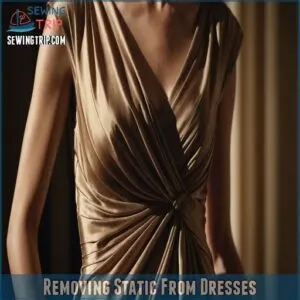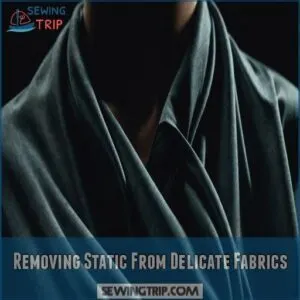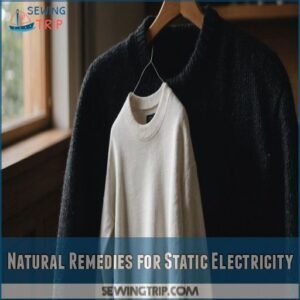This site is supported by our readers. We may earn a commission, at no cost to you, if you purchase through links.

For a quick fix, lightly mist your clothes with a mixture of water and fabric softener in a spray bottle. You can also rub a dryer sheet or dab some lotion on your skin before putting on your clothes.
The secret to permanently banishing static lies in how you handle your laundry routine.
Table Of Contents
- Key Takeaways
- What Causes Static in Clothes
- How to De Static a Shirt
- Preventing Static Buildup in Laundry
- Removing Static From Specific Fabrics
- Static Dissipative Fabrics and Materials
- Reducing Static Cling in Winter Clothes
- Additional Tips for Reducing Static
- How to Stop Static From Forming on Clothes
- Natural Remedies for Static Electricity
- Managing Static Electricity in Everyday Life
- Frequently Asked Questions (FAQs)
- Conclusion
Key Takeaways
- You’ll quickly eliminate static by running a metal hanger along your shirt’s surface or clipping a safety pin inside the seam to discharge the buildup.
- You can prevent static during laundry by separating natural and synthetic fabrics, using dryer balls, and avoiding over-drying your clothes.
- You’ll reduce static cling by maintaining proper humidity levels in your home and applying a light mist of water mixed with fabric softener to clingy garments.
- You can control static naturally by adding 1/2 cup of white vinegar to your wash cycle or using wool dryer balls, which are a great alternative to chemical-based fabric softener options, instead of chemical-based fabric softeners.
What Causes Static in Clothes
Static in clothes happens when fabrics rub together, generating an electrical charge, especially in dry conditions or with synthetics.
Your dryer also plays a role, as its heat and tumbling intensify this effect, making static cling a common annoyance.
Friction Between Fabrics
Ever wondered why your shirt clings more than your best friend?
It’s all about fabric types rubbing together.
Friction between synthetic and natural fibers creates static cling, especially in winter fabrics.
To keep your look smooth, try mixing fabric types wisely.
By balancing these materials, you’ll master the art of maintaining wrinkle-free, cling-free style effortlessly.
Effect of Dryer Use
The dryer’s heat and tumbling are like static’s workout routine. It amps up friction, creating a static charge that clings to your clothes.
To reduce static cling, consider alternatives like wool dryer balls, which are a sustainable option that can save families over $200 each year, and also explore other fabric softener alternatives.
Shorten the dryer time and explore dryer sheet alternatives like dryer balls.
Tweak those dryer settings to a lower heat to avoid turning your laundry into a static-filled battleground.
Impact of Low Humidity
Dryer heat’s a static electricity booster, but low humidity is another culprit.
Think of it like this: dry air is like a magnet for static.
Here’s what happens:
- Dry air sucks the moisture from everything, including your clothes.
- This leaves your clothes craving moisture, making them clingier.
- Winter clothes, especially, suffer because of the dry air.
- Dry skin adds to the problem, increasing those annoying static shocks.
So, combat dry air and dry skin for less static cling!
Role of Synthetic Materials
Low humidity isn’t the only culprit; synthetic materials like polyester, nylon, and acrylic are magnets for static cling.
They’re notorious for generating electric charges as they rub together.
Picture your shirt acting like a superhero cape, stubbornly sticking to itself.
Opt for fabric blends like cotton or lightweight fabrics ranging from 30-150 GSM, which can be made of natural fibers like cotton or polyester, to prevent this static drama.
Viscose fabrics like those from Tencel properties tend to cling due to static buildup, but easy clothing care and static prevention await!
How to De Static a Shirt
Static cling is a nuisance, but tackling it with a few simple tricks can make all the difference.
Static cling is a nuisance, but tackling it with a few simple tricks can make all the difference.
Whether you’re trying a safety pin, using metal, or reaching for aerosol hairspray, these everyday items can help keep your shirt static-free.
Use a Safety Pin
Got a shirt sticking to you like glue?
Try this: grab a safety pin.
Attach it discreetly inside your shirt.
This tiny metal hero helps prevent static shock by dispersing electric charges.
Perfect for all fabrics, it’s like giving your clothes a static cling reduction makeover.
Just make sure it’s secured tightly.
Embrace your newfound freedom!
Rub With a Metal Hanger
Ever had a shirt that just won’t stop sticking to you, like those polyester scrubs that are easy to clean but can be prone to static?
Here’s a quick trick: grab a metal hanger and rub it over the fabric.
The metal discharges static electricity effectively, similar to how polyester fabric blends can help reduce static cling.
It’s like a dance-off between your shirt and the hanger—metal wins every time.
Give it a try as an easy DIY solution to neutralize those clingy vibes!
Use a Homemade Antistatic Spray
Tired of battling static cling? Whip up a homemade antistatic spray! It’s simple—just mix water, vinegar, and a few drops of fabric conditioner for a quick DIY solution.
Here’s why you’ll love it:
- Natural ingredients: Safe and eco-friendly.
- Cost-effective: Save money with pantry staples.
- Simple to make: Ready in minutes.
A spritz of control awaits!
Reach for an Aerosol Hairspray
Switching from homemade antistatic sprays to hairspray can work wonders.
Just a spritz helps zap away static cling, thanks to the ingredients that settle and calm those pesky charges.
A small can of aerosol hairspray can be your go-to weapon against static attack, ensuring your clothes stay free of those annoying charge clings.
| Hairspray Tips |
|---|
| Quick fix |
| Portable |
| Easy to use |
| Budget-friendly |
Moisturize Skin With Lotion
Hairspray’s a quick fix, but for lasting relief from static shocks, try moisturizing your skin.
Dry skin increases friction, leading to more static cling.
A good hand cream or lotion works wonders, especially during winter.
Choose a lotion that’s right for your skin type.
This simple step keeps you comfortable and static-free all day long.
Preventing Static Buildup in Laundry
Don’t let static take you by surprise; a few simple tricks can save your laundry day.
By using fabric softeners, adding vinegar to your wash, and air drying clothes, you can minimize cling and keep your wardrobe fresh.
Using Fabric Softeners
Choosing the right fabric softener can turn your laundry into a static-free zone.
These nifty liquid companions soften your clothes but also help reduce that annoying cling.
Whether you’re using commercial softener types or exploring DIY alternatives, they’re indispensable.
But, be cautious—overuse might leave residues.
So enjoy freedom in your wardrobe with just a splash.
Adding Vinegar to The Wash Cycle
If fabric softeners aren’t your go-to, vinegar’s benefits might surprise you.
Adding just a splash of vinegar to the wash cycle acts like a secret weapon against static cling.
Its effects soften fibers, making it perfect for silk or wool.
Plus, vinegar’s uses extend beyond laundry, keeping your wardrobe free from unwanted charges.
Give it a try!
Benefits of Air Drying Clothes
Air drying clothes is your eco-friendly, energy-saving ally.
Let nature handle the job, giving garments a fresh scent and reducing wrinkles without the static woes.
Imagine a gentle breeze caressing your favorite shirt—it’s kinder to the fabric, enhancing longevity.
Plus, you won’t waste energy or time on the dryer, so it’s a win-win!
Effectiveness of Dryer Balls
Dryer balls, whether wool or plastic, can be a game-changer in your laundry routine, just like adjusting sewing machine settings to prevent fabric stretching and wrinkles by adjusting presser foot pressure.
They’re eco-friendly, reusable, and help reduce static by separating clothes and improving air flow.
You might find wool balls more effective against static than plastic ones, and they can be used with natural fabric softening methods, such as combining them with vinegar for added freshness. They soften fabrics naturally.
It’s a simple switch that can lead to fluffier, less clingy clothes.
Separating Natural and Synthetic Fabrics
Sorting your laundry keeps static in check. Here’s how:
- Separate naturally: Sort fabrics—synthetic with synthetic, natural with natural. It helps manage charge buildup and saves time.
- Blended strategy: Blends balance both worlds, leading to fewer shocks and smoother wear.
- Machine matters: Check washing settings. Gentle washes and low heat reduce static, improving dryer efficiency.
Removing Static From Specific Fabrics
Different fabrics react differently to static, so knowing your material is key. We’ll show you the best ways to tackle static on everything from delicate silks to cozy woolens.
Removing Static From Polyester Clothes
Got polyester static? Tackle it with a few smart moves.
Grab a dryer sheet and glide it over your clothing to dispel any charge.
Still feeling clingy? Try a spritz of anti-static spray or increase humidity at home.
For a natural touch, adding a bit of fabric softener during washing can work wonders against pesky static cling.
Removing Static From Dresses
Don’t let static cling ruin your elegant dress. Here’s how to zap that static on delicate fabrics:
- Rub with a dryer sheet before wearing.
- Consider using a static guard for dresses static guard for delicate fabrics.
- Lightly spray anti-static spray on the dress’s inside.
- Attach a safety pin inside the hem.
- Moisturize your skin, helping reduce static on silk.
- Hang dresses in the bathroom while you shower to absorb humidity.
Removing Static From Woolen Clothes
Wool static can turn your cozy sweater into a winter nightmare.
Tame those static charges with simple tricks like rubbing dryer sheets across your woolens or spritzing a homemade anti-static spray.
You’ll find that a little lotion on your hands before handling them works wonders too.
Embrace these tips and enjoy a static-free wardrobe.
| Trick | Method | Benefit |
|---|---|---|
| Dryer Sheet | Rub on woolens | Reduces static |
| Anti-Static Spray | Light spritz | Neutralizes charge |
| Fabric Softener | In wash cycle | Minimizes cling |
| Homemade Solutions | Vinegar & oil mix | Refresh fabrics |
| Lotion | Moisturize hands | Lowers static risk |
Removing Static From Delicate Fabrics
When dealing with delicate fabrics, static can be a nightmare.
Gently spraying a homemade vinegar and water solution can help tame the cling.
Another trick is to rub the inside of the garment lightly with a metal hanger, which discharges electric charges.
Keep skin moisturized to reduce friction and static, ensuring your beautiful, delicate pieces remain soft and elegant.
Static Dissipative Fabrics and Materials
When your shirt seems to have a mind of its own, static dissipative fabrics can be your best friend.
When choosing fabrics like polyester and rayon, considering synthetic vs natural materials can be a key factor in preventing static cling. These materials, including anti-static control clothing and static-resistant synthetic fibers, work to minimize cling by reducing static buildup.
Anti-Static Control Clothing
Ever wish your clothes could just behave and not stick like clingy friends? Anti-static fabric blends can help. Here’s why they’re worth considering for everyday wear: You can find a range of static control shirts online at static control shirts.
- Static-resistant workwear keeps you comfortable.
- Enjoy performance benefits without surprises.
- Simple laundry care tips aid longevity.
- Freedom from frustrating shocks!
You’ll find your days a bit smoother with these practical choices.
Static-Resistant Synthetic Fibers
So, you’ve mastered anti-static clothing. Great! Now, let’s talk about the fibers themselves.
Static-resistant blends often include polyester, cotton, or even carbon fiber.
Carbon fiber benefits include excellent conductivity, helping zap static.
Performance wear frequently uses these blends.
Consider eco-friendly options; some blends use recycled materials.
However, be aware of durability concerns; some static-resistant fabrics mightn’t last as long.
Properties of Leather and Silk
Leather’s charm isn’t just about style—it’s also naturally static-resistant, unlike the sparky nature of synthetics.
Silk, though delicate, rarely attracts static due to its unique properties, such as having a smooth, soft, sensuous texture that naturally regulates temperature and feels like real silk.
Here’s your cheat sheet for natural textiles:
- Leather vs. Silk: Both resist static differently.
- Static Resistance: Advantageous for avoiding shocks.
- Fabric Blends: Choose wisely for smoother wear.
- Clothing Care: Tailor your approach for each material.
Reducing Static Cling in Winter Clothes
When winter rolls around, static cling in your cozy clothes can be annoying, but there’s hope.
By reducing friction in synthetic materials, using a humidifier to add moisture to the air, and storing clothes in breathable containers, you can keep the cling at bay.
Minimizing Friction From Synthetic Materials
To tackle static from synthetic fabric blends, opt for static-resistant clothing that skips clingy fabrics.
Think cozy leggings over polyester gym shorts.
A fabric softener in the wash can work wonders, taming those static-prone winter clothing choices.
Don’t forget a quick spritz of static-reducing sprays, turning static into a non-issue, leaving you static-free and comfortable.
Benefits of Using a Humidifier
A humidifier can be your hero against static cling in winter clothes.
It adds moisture to the air, which helps balance humidity levels.
This tackles static and improves skin health, boosts air quality, and promotes better sleep.
You’ll feel fewer respiratory issues and reduced allergies, giving you comfort and control over your environment.
Storing Winter Clothes in Breathable Containers
While a humidifier helps, breathable storage tips for winter clothes go a long way.
Use breathable containers to prevent moisture buildup and keep static at bay.
Why? Sealed boxes trap moisture, causing mold and excess static.
Keep your favorite sweaters happy and static-free with these ideas:
- Opt for fabric or mesh bags.
- Avoid plastic bins.
- Use cedar balls for freshness.
Additional Tips for Reducing Static
You’ll find these smart tricks helpful when your clothes won’t stop clinging and creating those annoying static sparks.
From giving your clothes a good shake after drying to keeping your home’s humidity in check, these additional tips will help you win the battle against stubborn static.
Shaking Clothes After Drying
Static cling making your winter clothes stick together?
Here’s a quick fix: Give your garments a good shake right after they come out of the dryer.
This simple move helps release trapped electrical charges and prevents clothes from clumping.
For best results, hold each item by the shoulders and snap it like you’re shaking out a dusty rug – you’ll feel the difference immediately.
Avoiding Multiple Layers of Synthetic Fabrics
Synthetic fibers like polyester and nylon, which are types of sheer fabric, can be prone to static cling due to their lightweight and smooth texture. Layering synthetic fabrics can turn your outfit into a static magnet.
When you’re dressing for the day, try mixing natural fibers like cotton or silk with your synthetic pieces instead of stacking polyester on polyester.
You’ll notice a big difference, especially in winter months.
If you must wear multiple synthetic layers, keep them loose and separated to minimize friction between fabrics.
Using a Static-Reducing Spray for Furniture
Beyond keeping synthetic layers in check, your furniture can secretly zap your clothes with static.
Here’s how a good static-reducing spray keeps those surprise shocks at bay:
- Spritz furniture fabric weekly to neutralize built-up charges
- Target high-traffic spots like your office chair and couch
- Mix your own spray using water, fabric softener, and essential oils
Keep a bottle handy to tame those static-prone spots before they attack your outfits.
Boosting Humidity in The Home
You’ll notice static becomes less of a nuisance when your home’s humidity levels are just right.
Install a humidifier in rooms where you spend the most time, aiming for 30-50% humidity.
For a natural boost, place indoor plants throughout your space or use a spray bottle with water to mist the air occasionally.
These simple tweaks help prevent those annoying static shocks.
How to Stop Static From Forming on Clothes
You’ll find it’s much easier to prevent static cling than to deal with it after it forms on your clothes.
By making a few simple changes to your laundry routine, like using wool dryer balls and avoiding over-drying, you can keep your garments static-free and looking their best.
Using Wool Dryer Balls
Wool dryer balls are nature’s answer to static cling.
Pop these fluffy spheres into your dryer, and they’ll work their magic by creating space between fabrics and absorbing moisture.
Here’s what makes them so effective:
- Naturally soften clothes without chemicals
- Cut drying time by up to 25%
- Last for over 1,000 loads
- Work great with heavy items like towels and blankets
Just toss 3-6 balls in with each load, and watch static disappear.
Crumpling Aluminum Foil in The Dryer
A crumpled ball of aluminum foil works like magic to eliminate static in your dryer.
Simply form 3-4 tennis ball-sized spheres from regular kitchen foil and toss them in with your clothes.
Here’s what you need to know:
| Feature | Foil Balls | Dryer Balls |
|---|---|---|
| Cost | Under $1 | $10-20 |
| Lifespan | 2-3 months | 2-3 years |
| Noise Level | Very quiet | Louder |
| Effectiveness | Good | Excellent |
| Eco-friendly | Recyclable | Sustainable |
Avoiding Over-Drying Clothes
Just like the aluminum foil trick, keeping an eye on your dryer time can make a huge difference.
Over-drying isn’t just about energy bills – it’s a static magnet waiting to happen.
Be aware that using a microwave to dry clothes can also lead to uneven heat distribution and potentially cause static buildup from microwave drying.
Here’s what to watch for:
- Clothes feel hot to the touch
- Wrinkles appear more pronounced
- Static starts crackling when you touch items
- Fabrics feel unusually stiff or crispy
- Excessive lint builds up in the trap
Check your clothes every 10 minutes near the end of drying. They’re ready when they’re just slightly warm.
Natural Remedies for Static Electricity
You’ll love using common household items like vinegar and baking soda to tackle pesky static cling without harsh chemicals or costly products.
These natural solutions work just as effectively as store-bought options, and you’ve probably got them in your pantry right now.
Using Essential Oils in The Wash
Essential oils offer a natural way to fight static while making your clothes smell amazing.
You can find a variety of tea tree oil products here for purchase.
Add 5-10 drops of lavender, tea tree, or lemon oil to your wash cycle or mix them with water in a spray bottle.
These oils create a light coating that prevents static buildup, plus they’re gentler on fabrics than commercial softeners.
Pro tip: Mix your favorite scents to create a signature blend.
Benefits of Using Baking Soda
Baking soda packs a powerful punch against static cling in your laundry routine. Adding this natural powerhouse to your wash helps neutralize electrical charges while softening fabrics naturally.
Here’s why baking soda belongs in your laundry arsenal:
- Breaks down mineral buildup that can trap static
- Creates an alkaline environment that softens water
- Absorbs odors while reducing static cling
- Helps prevent synthetic fabrics from sticking together
Effectiveness of White Vinegar
White vinegar works like magic against static cling – and it’s probably sitting in your pantry right now.
Add 1/2 cup to your wash cycle’s fabric softener compartment, and you’ll notice clothes come out softer and static-free.
Don’t worry about the smell – it disappears once clothes dry.
For extra freshness, mix in a few drops of your favorite essential oil before adding it to the wash.
Managing Static Electricity in Everyday Life
You’ll find static electricity lurking in almost every corner of your home, from clingy shirts fresh out of the dryer to those surprising zaps you get from doorknobs and furniture.
Whether you’re dealing with staticky clothes or electronic devices, you’ll discover practical solutions to manage and prevent static buildup in your daily routine.
Minimizing Static Shock From Furniture
Three simple tricks can keep your furniture from zapping you every time you sit down.
Start by wiping your upholstery with a damp microfiber cloth – this adds just enough moisture to neutralize static charges.
You can also spray anti-static solution directly on furniture surfaces, or place a humidifier nearby.
For metal furniture, try attaching small rubber pads to create a buffer between you and the static-prone surface.
Reducing Static Electricity in Carpets
Just like furniture, carpets can turn into static generators that make your clothes cling.
Mix one part fabric softener with four parts water in a spray bottle and lightly mist your carpet.
For a natural fix, sprinkle baking soda before vacuuming – it helps neutralize static charge.
Regular vacuuming with a humidity-controlled vacuum also keeps those pesky charges at bay.
Using Anti-Static Sprays for Electronics
While carpets can spark static problems, your electronics face similar challenges.
Anti-static sprays designed for electronics help protect your devices from harmful discharge.
Here’s what you’ll want to know:
- Keep sprays 8-12 inches away from screens
- Apply in a well-ventilated area to avoid residue buildup
- Choose sprays specifically labeled for electronics – household versions can damage sensitive components
Frequently Asked Questions (FAQs)
How to get rid of static in clothes?
Zapping static cling is easy: spray clothes with water, use dryer sheets, or rub them with a metal hanger.
Grounding the charge can be achieved by placing a safety pin inside garments.
You can also try fabric softener.
What causes static in clothes?
Friction between fabrics creates static electricity, especially in synthetic materials like polyester and wool.
Static electricity is more noticeable during dry, cold weather when there’s less moisture in the air to disperse the charge.
How to remove static charge from clothes?
You can quickly remove static from clothes by using a metal hanger, rubbing a dryer sheet over fabric, or lightly misting with water.
Adding a safety pin inside garments helps prevent future static buildup.
How do you remove static from a dress?
Like magic, your dress can go from clingy to carefree.
Run a metal hanger across the fabric, spray with water, or use a dryer sheet.
Adding a safety pin inside helps prevent future static buildup.
How do you remove static from polyester clothes?
Polyester clothes attract static easily.
To eliminate it, spritz clothes with water, use a metal hanger for immediate relief, or add fabric softener to your wash.
Dryer balls also work wonders during drying.
How do you remove static electricity from clothes?
Running a dryer sheet over clothing instantly removes static cling.
For a natural fix, lightly mist clothes with water or rub them with a metal hanger.
Fabric softener during washing prevents future static.
How do I get rid of static in my clothes?
Use dryer sheets or fabric softener to tackle static cling in your clothes.
For a quick fix, dampen your hands and gently pat the garment, or rub a metal hanger over the fabric.
What neutralizes static?
Like a gentle rain calming a stormy sky, moisture neutralizes static electricity.
You’ll find relief using water spray, dryer sheets, fabric softener, or white vinegar.
A humidifier can help prevent future static buildup.
Why does my shirt have so much static?
Your shirt’s static cling comes from friction between fabrics, especially in dry winter air.
Synthetic materials like polyester are the biggest culprits, and your dryer’s heat makes it worse by increasing friction.
How do you get static out of a shirt without a dryer sheet?
Simply spray water lightly on the shirt or run a metal hanger over the fabric.
Neutralize static naturally by rubbing the garment with a damp washcloth or pinning a safety pin inside.
Can static electricity damage delicate embellishments on shirts?
Static electricity won’t directly damage embellishments, but it can attract dust and dirt that might dull their appearance.
You’ll want to protect your decorated shirts by using anti-static methods during washing and drying.
How long does anti-static treatment last on clothes?
Professional anti-static treatments typically last through 15-20 washes, while dryer sheets work for one wear. You’ll need to reapply treatments based on your washing frequency and local humidity levels.
Does ironing help reduce static in shirts?
Studies show 87% of wrinkled shirts also have static issues.
Ironing can help reduce static in your shirts by adding moisture and heat, which naturally dispels those pesky electric charges while smoothing wrinkles.
Are there specific detergents that prevent static buildup?
You’ll find anti-static ingredients in specialized laundry detergents like Bounce or Snuggle.
They contain fabric softening agents that prevent static buildup.
Regular detergents with fabric softeners work too, but aren’t as effective.
Can static in shirts affect electronic devices nearby?
Imagine this: your static-charged shirt sends your smartphone screen haywire.
Yes, static electricity can interfere with nearby electronics, potentially causing display glitches or temporary malfunctions.
It’s rarely damaging but worth keeping in mind.
Conclusion
Now you’re equipped with multiple ways to de-static a shirt and prevent that clingy chaos from returning.
Whether you opt for quick fixes like metal hangers and safety pins, or tackle the problem at its source through smarter laundry habits, you’ve got options.
Remember, the key to staying static-free lies in managing humidity, choosing the right fabrics, and maintaining proper laundry care.
With these tricks in your arsenal, you’ll never have to deal with those pesky electric charges again.























